Paint Beautiful Decorative Flowers!
This week, we create stylized beauty. You will see how I painted these beautiful decorative flowers.
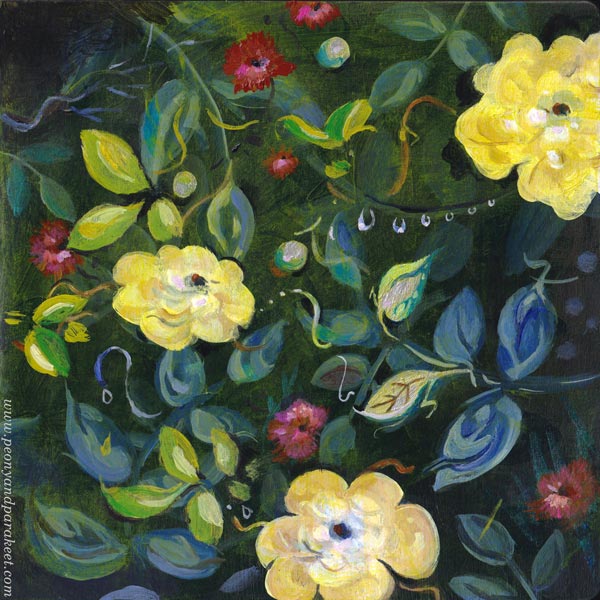
Time for Some Happy Art!
At least here in Finland, May-June is a time for parties. There are school graduations and then Midsummer at the end of June, which is celebrated not only by people but by Finnish nature too. Days are long and the deep sleeps during the dark winter are now coming into use. If different art forms had seasons, this uplifting time would be dedicated to decorative painting. Beautiful decorative flowers and other curvy motifs go well with the celebrations.
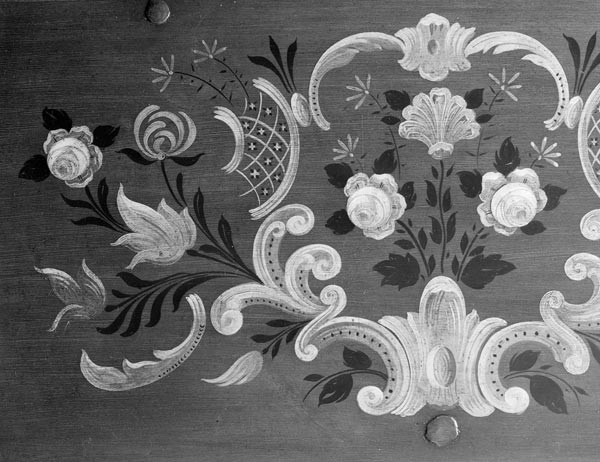
Decorative art is happy art for most people. Its tradition extends all over the world and it only requires a little sensitivity to beauty from the viewer.
Uplifting Art-Making
Three years ago, when the Corona lockdowns started, I buried myself in decorative painting. I made decorative collages from hand-painted papers and practiced decorative painting techniques.
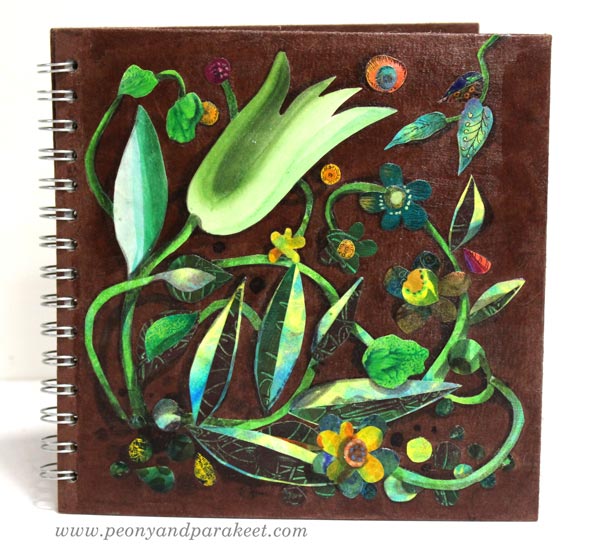
These curvy forms and lines are still present in my paintings, where decorativeness is mixed with a more dynamic and abstract expression.
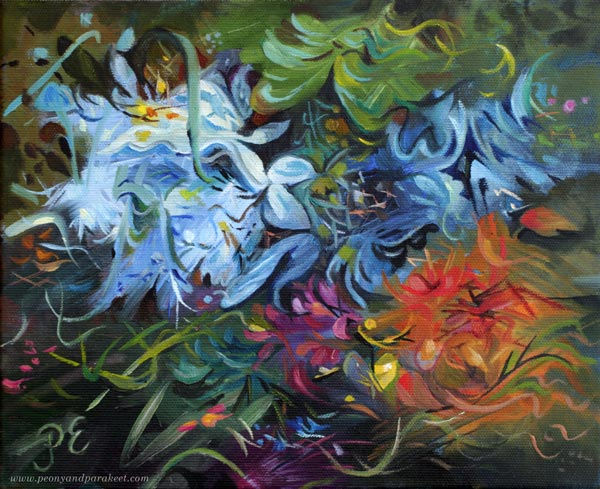
Painting in a decorative style is fun. A few thoughtful brushstrokes create beauty, and even a beginner’s work looks great when viewed from a far enough distance. Over time, the brush mark improves and has an effect on all drawing and painting, even handwriting. And it’s the perfect style for cards and gifts!
Starting a Decorative Painting
As I watched the blossoms in apple trees, I felt like painting something small and nice to celebrate the beginning of the blooming season.

I took out my black Dylusions Creative Journal and acrylic paints and painted the background very dark blue. Then I made leaves on top of each other, and so that they get lighter layer by layer.
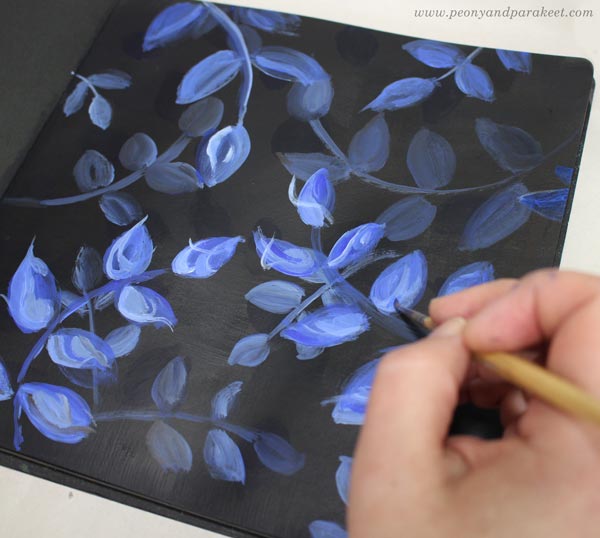
At the same time, I watched the videos of my course Decodashery.
Decodashery – Painting Techniques for Vintage Flowers and More
I still like this course a lot. Decodashery is beautiful, inspiring, and detailed in its instructions. It is also full of ideas. When the Corona lockdown was on, I had plenty of time to experiment with decorative painting and make more examples than usual. This course is for watercolors, gouache, and acrylic paints. You can choose what you want – most of the decorative techniques suit all of them.
Beautiful Decorative Flowers in Two Parts
At first, I thought about making two separate paintings for this post but then decided to make one work in two parts. The first part is simple and stylized and the second part is more creative. In this first part, I used quite raw colors: mainly ultramarine blue and white. I also mixed some brown umber with them.
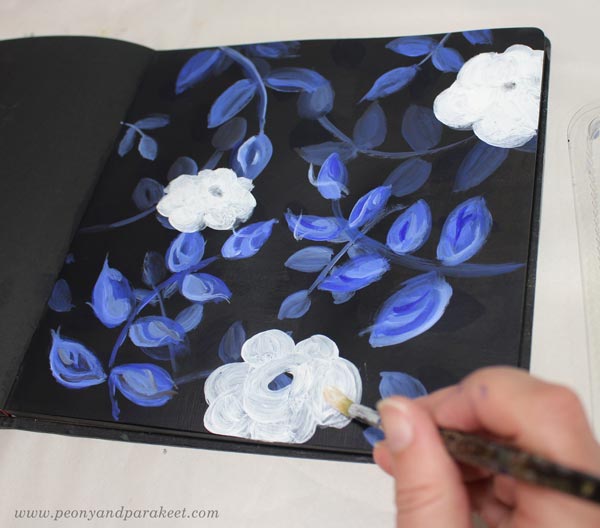
To highlight the decorative theme, I painted some parts with silver acrylic paint.
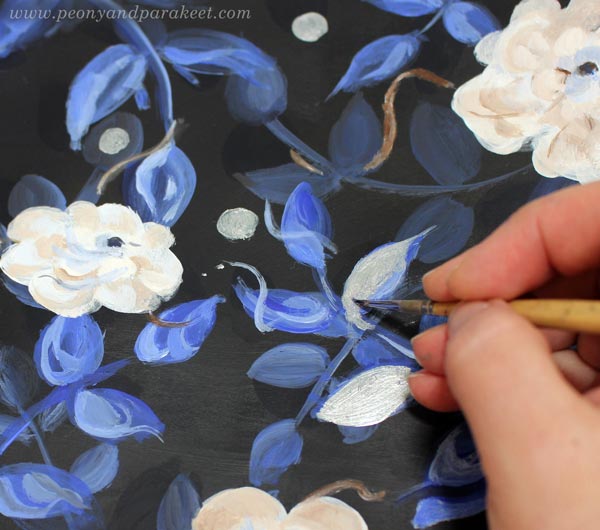
Finally, I added some Sienna brown and turquoise (manganese blue hue) to bring warmth to the details.
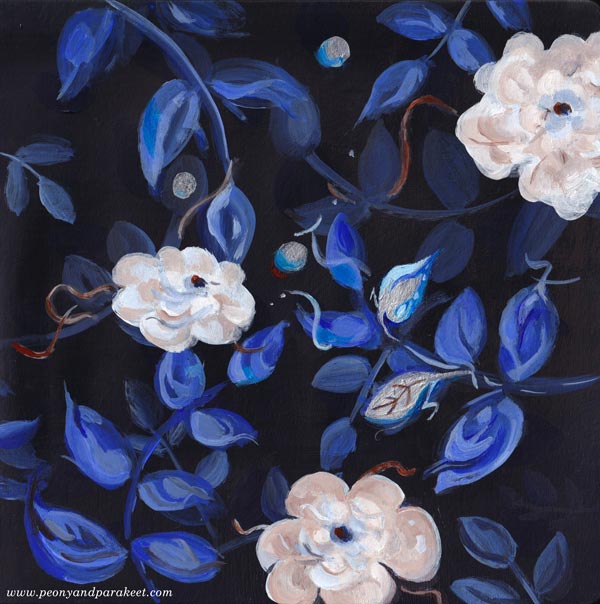
Now the first part is finished. The flowers that are only partly visible give the impression of continuous space.
Beautiful Decorative Flowers – The Second Part
In the second part, I wanted to bring more depth and warmth to the work. So I spread a thin layer of yellow-green color over the painting.
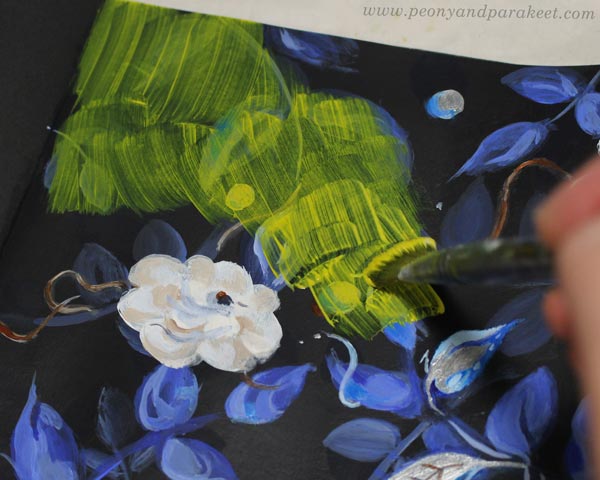
I used glazing gloss as a thinner here, but you can also try to thin the paint with water.
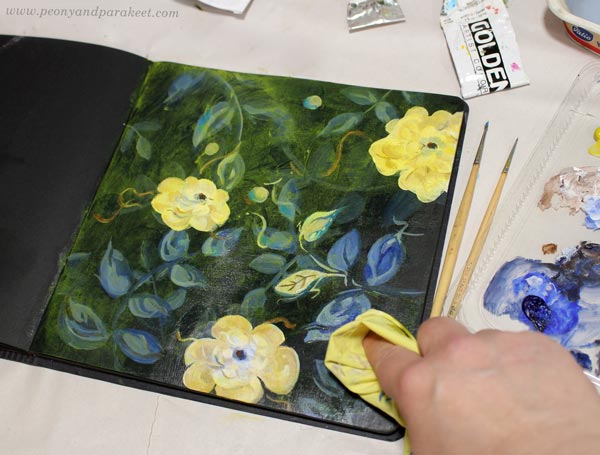
Immediately after application, I removed the excess paint by rubbing the surface with a cotton cloth. The thin color wash warms the tones of the whole painting.
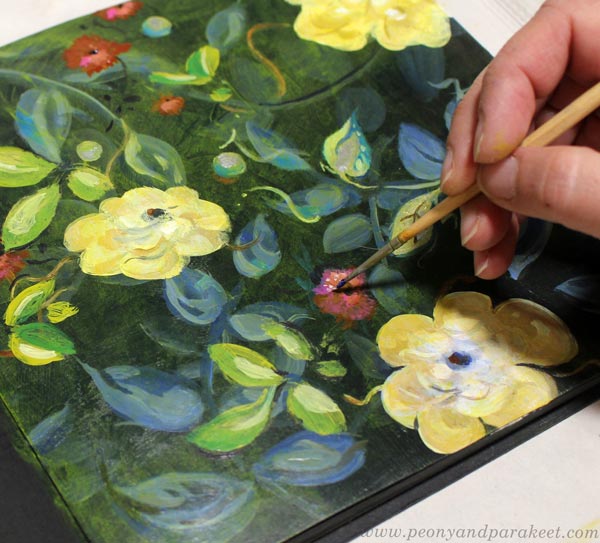
After the color wash, the painting is a bit hazy. Next, I added more details and brought some of them back up from the lower layers. This sharpens the best parts.
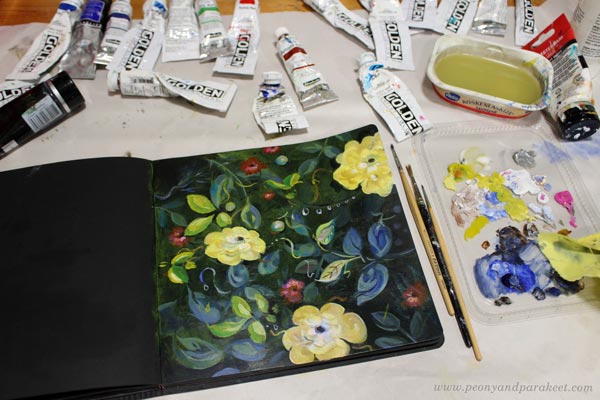
I had lots of tubes on the table but only used a few. Decorative painting encourages making a variety of tones by adjusting the lightness and darkness of color instead of always changing the actual color.
Happy for the Artist, Happy for the Viewer
There were moments of joy that only decorative painting can give me while making the page. This style feeds gentleness and peace. And even if the pleasures of the decorative painting process are only experienced by the painter, the decorative painting leads to results that are extrovertedly joyous, ready to brighten up anyone’s day.
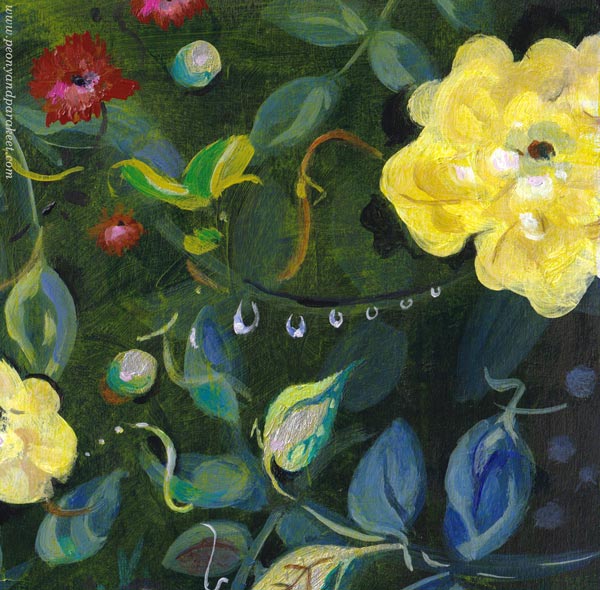
Decodashery online course – Paint vintage beauty – Buy Now!
Gold Caches of Your Artistic Journey
This week, I talk about the balance between following others and doing your own thing.
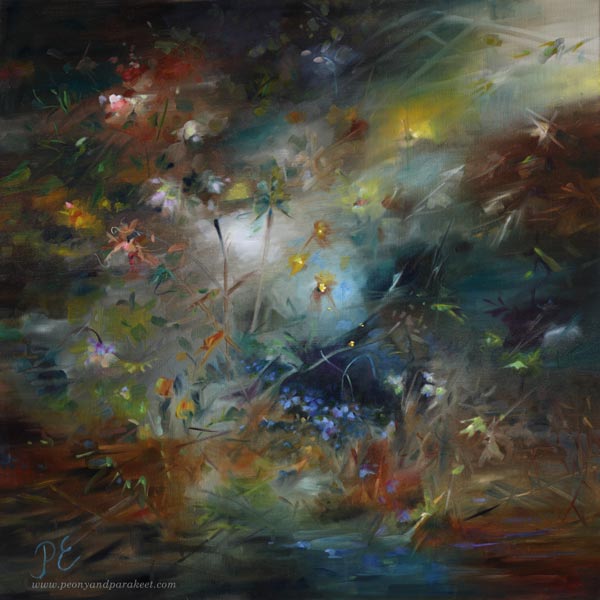
– Do what everyone else does.
That’s what my mother often told me when I was a child. Her point was to encourage me to learn and be part of a crowd – important skills, but I hated that phrase. As if you shouldn’t deviate from the path, stop, or run faster!
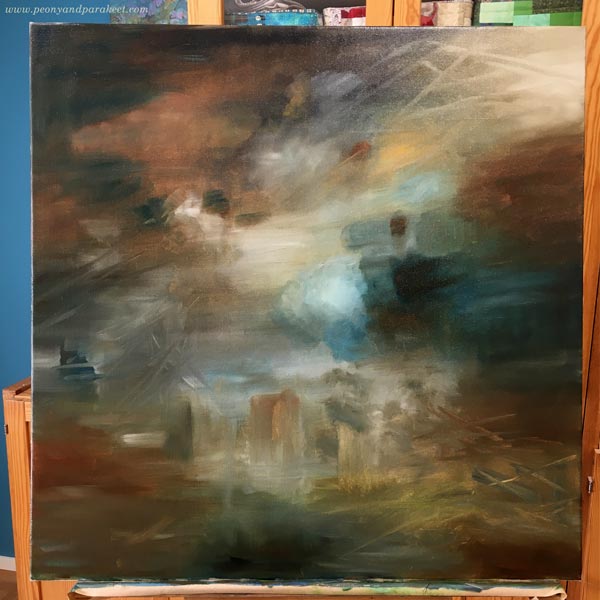
As an adult, I learned that life is not just about moving on your own. Everyone needs public transport.
Helsinki Bus Station Theory for Artists
Have you heard about Helsinki Bus Station Theory? It is particularly familiar to us southern Finns. Most of the buses in Helsinki go a long way on the same road until they take a different direction. “Stay on the bus, don’t hop off too soon,” we advise. This also applies to many things in life.

As artists, we don’t want to be like everyone else, but to hop off and find our own thing. And yet, to get to our own remote area with our treasures, we have to sit on the bus for quite a while. If we leave too early, we won’t find the caches, because they are much further away than we initially thought.
Traveling with Companions
We all have artistic talents that are strengthened by the journey together. This is why I teach classes.
If we get off too early, our talents won’t emerge. Ingenuity turns into chaos in the eyes of the viewer. Intuitiveness makes us do ordinary things because we can’t express its nuances. Sensitivity appears as unnecessary cautiousness. Analyticity produces a rigid impression and our personality is covered in an internal struggle about what the image should look like.
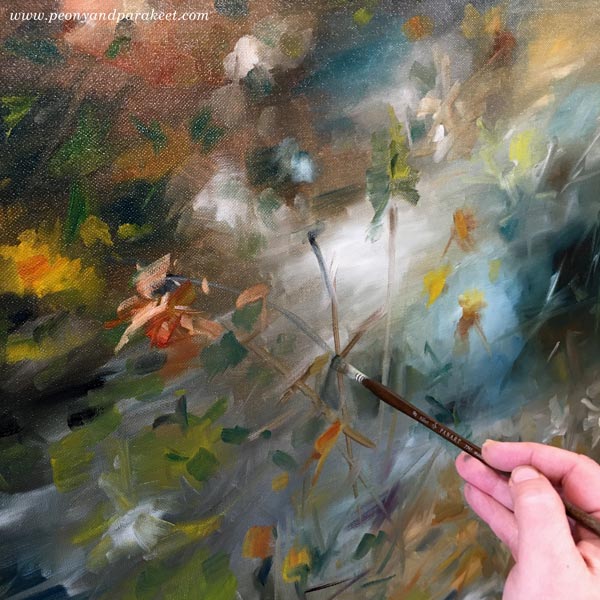
Through art history, I have understood that traveling with a companion can be enormously inspiring. As artists, we are always part of the past generations. When we look at old paintings, we can have a dialogue not only with ourselves and with our current teachers, but through our imagination, also with the masters themselves.
Gold Caches
Before I started this painting, I was looking at a portrait of Louis Pasteur by Albert Edefelt. Did Edelfelt guess how important a person Pasteur would become? I told Albert that we still benefit from Louis’s inventions. So, his glass bottles and notebooks were like gold caches.
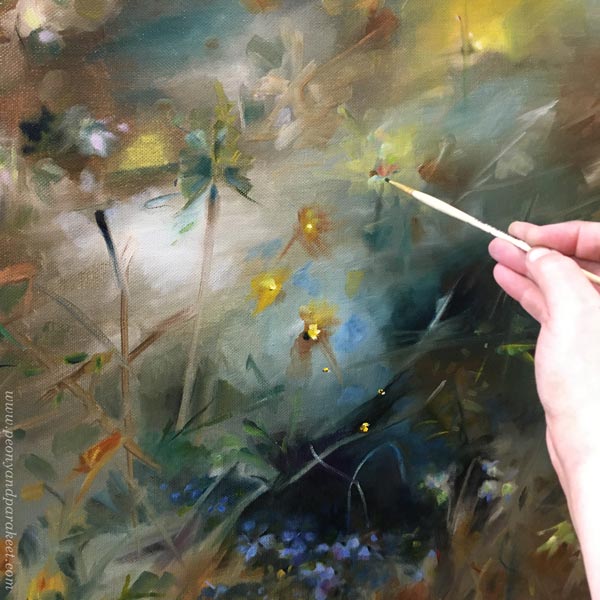
My gold caches are found in nature. When I walk on the wide path of a nearby park, I often turn my gaze to the shadows. When the sun hits there, a humble plant suddenly finds itself at the center of the scene.
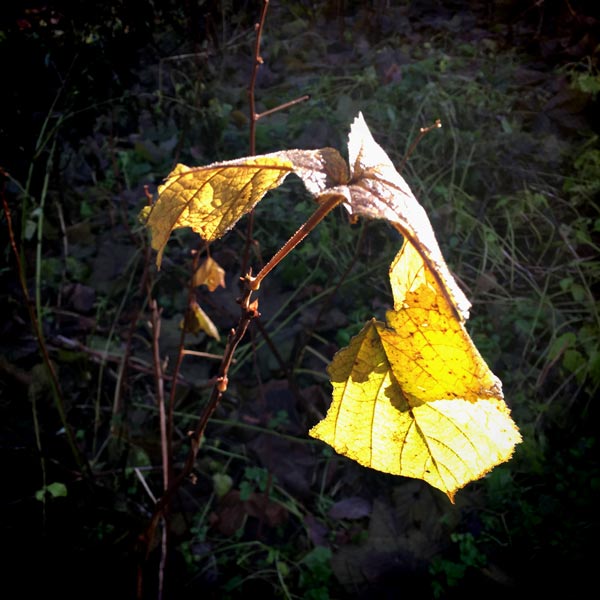
When that happens, I don’t only stare at the star of the show, but look around and notice all kinds of other wonderful things.
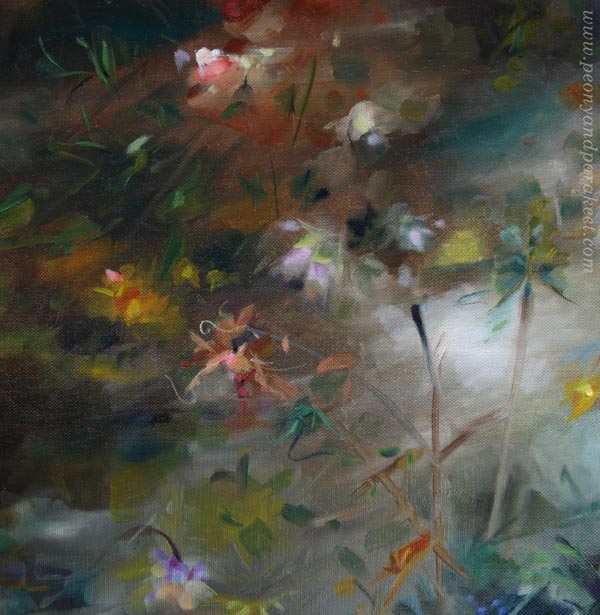
As a child, I already knew that it is not always good to march on and act like everyone else. It just has taken all my life to express that by painting.
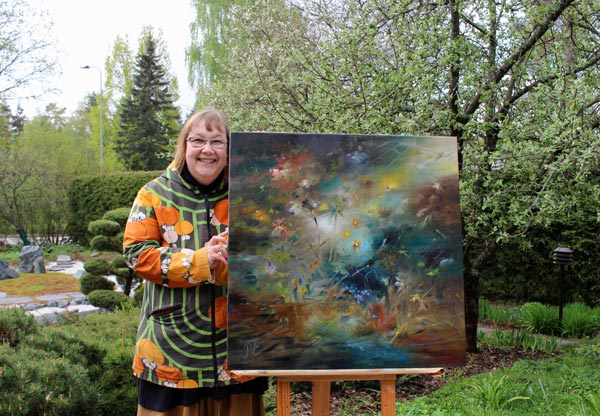
Did you know about Helsinki Bust Station Theory before? Where your gold caches could be? What do you think about all this?
Abstract Birds
There is a saying that if you don’t know what else to add “Put a bird on it!” But this week I want to talk about birds as the main object of the picture, not just as a decoration. This blog post is also about abstract birds and their connection with realistic bird art.

Here’s my new painting, also bird-themed!
The Love for Real Birds
As a child, I saw a lot of birds and at some point, I started to learn to identify them. Ornithologist sounded like a great word and I have always been fascinated by people who are extremely enthusiastic about something. I learned about birds from a bird book I got from my parents, which was illustrated with drawings. I also drew birds myself, and it’s quite easy to recognize them once you’ve once drawn every detail.
Since those times my knowledge has unfortunately deteriorated, and I never became an ornithologist! But even though I’m no longer good at identification, I know birds as animals well. After all, I have had pet birds for decades. At the moment I have two budgies, Leonardo and Primavera. Over time, my interest in wild birds has started to return and a dream has surfaced, which the newest painting “Kingfishers” also tells about.
Here’s how it started! Wild strokes here and there.
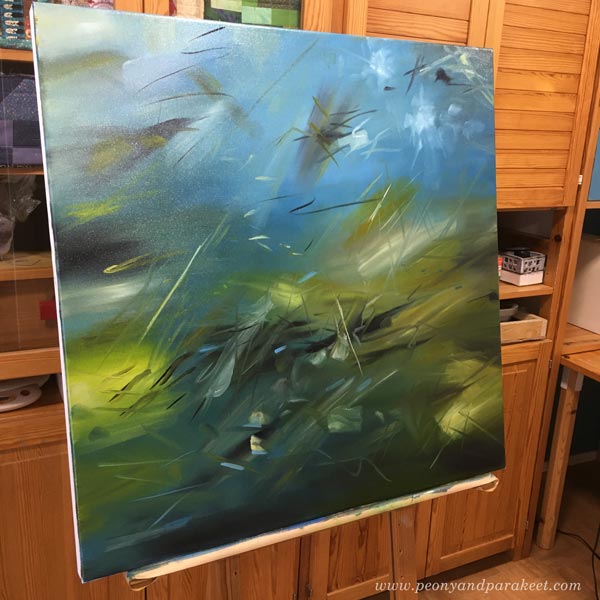
I think most of us have some relation to birds – what’s your story? Could you bring more of that to your art?
Dreaming of Birds
Ever since I was a child, I’ve wanted to see the kingfisher. In recent years, I’ve started imagining how one would sit on top of our mailbox on a summer’s day when I come down the hill towards home. And this spring I’ve started imagining kingfishers flying around the ditch along my walking path. I know that these are unlikely to come true, but they are still wonderful thoughts. Kingfishers are very rare here in Finland.
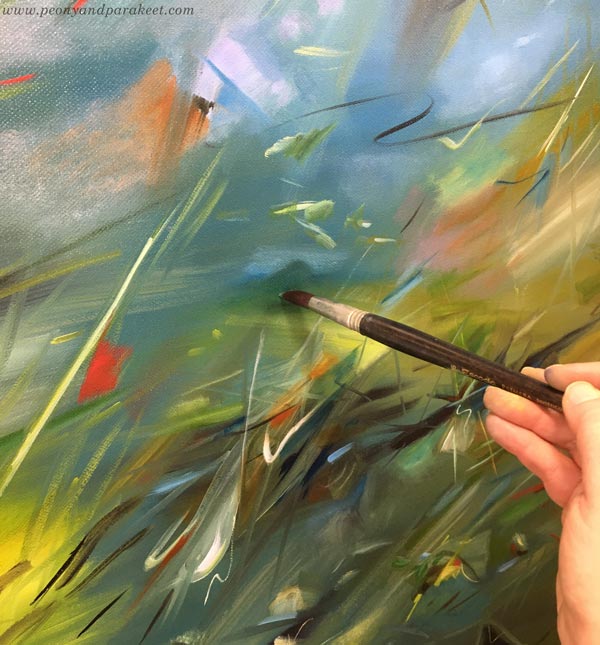
So when I started a painting inspired by the ditch, I wanted those kingfishers there. After all, I had already written “kingfisher” in my notebook earlier this year when I started planning the new series of paintings.
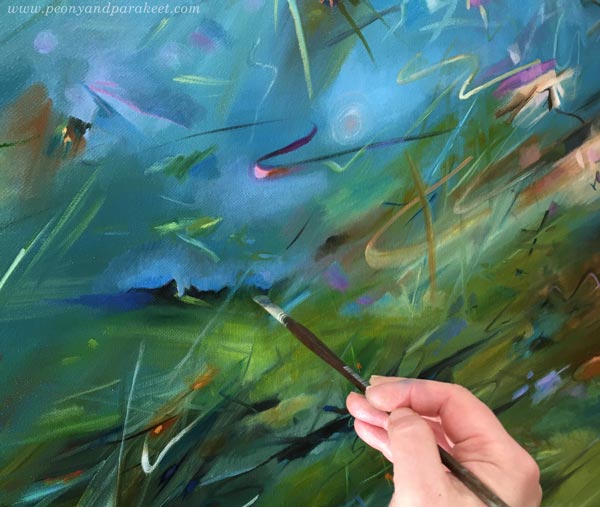
And when I researched the subject more, I found out that there are about 120 species of kingfishers. So I could paint many different ones in the same picture!
Birds by Von Wright Brothers
This month, I want to blog about art history too. And as a Finn, I have to introduce the brothers Magnus von Wright (1805–1868), Wilhelm von Wright (1810–1887), and Ferdinand von Wright (1822–1906). One of the most famous paintings here in Finland is “Taistelevat metsot”.
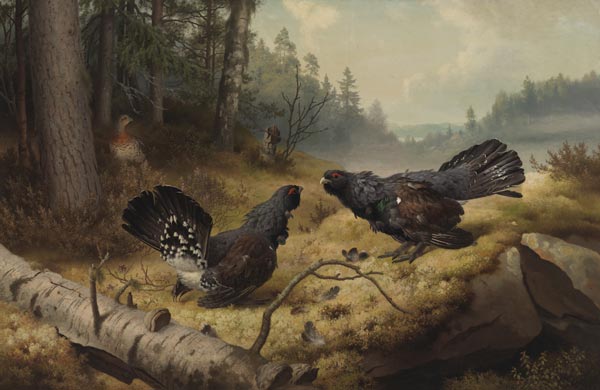
Von Wright brothers drew and painted huge numbers of birds and are remembered as bird artists. I saw this pigeon painting in the Ateneum Art Museum in 2018 when they had a big exhibition of von Wrights’s art.
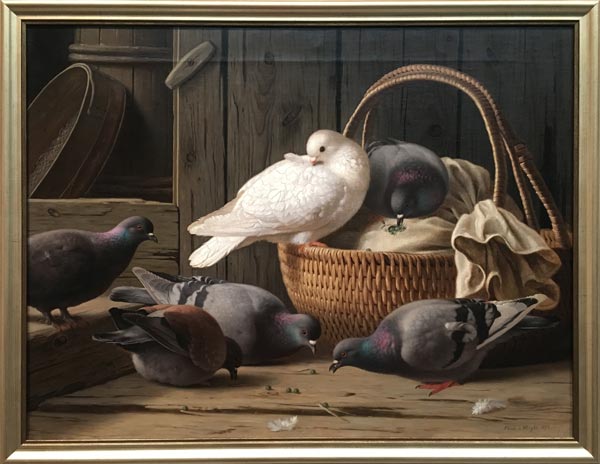
For the Von Wrights, the recognisability of bird species was essential, and they also depicted birds from the perspective of their authentic living conditions and behavior.
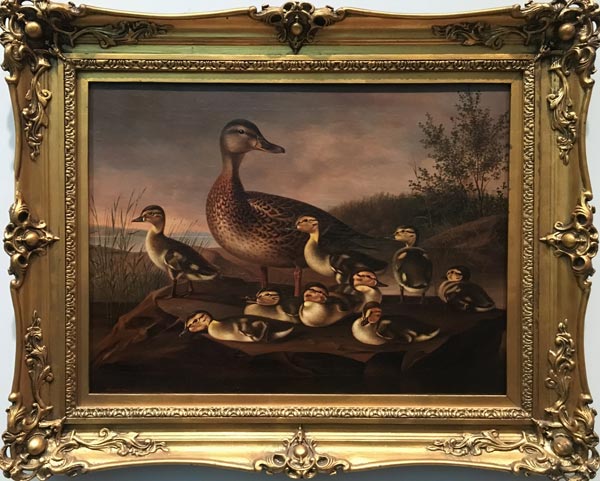
The paintings were very stylish and very aesthetic, but because of their accurate details, they also worked as scientific illustrations.
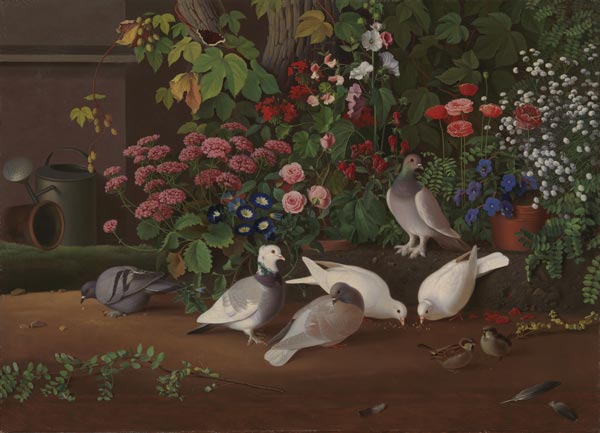
Unlike the von Wrights, I am not interested in the exact description of bird species, but rather in describing the vitality of life through birds.
Flying Birds and Their Abstract Shapes
I am especially fascinated by the ability to fly and I always try to look as closely as possible when I see a bird flying in the sky. When the bird flies high, its image breaks up and becomes an abstract composition. The flying bird serves us modern art in the middle of the mundane reality. A museum experience without visiting one!
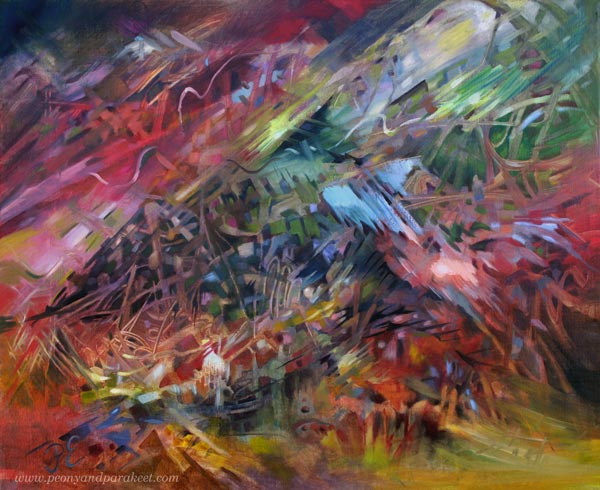
I often see finches and magpies here where I live. I think magpies are really beautiful birds and this painting of Ferdinand von Wright is fabulous even if its theme is a bit brutal.
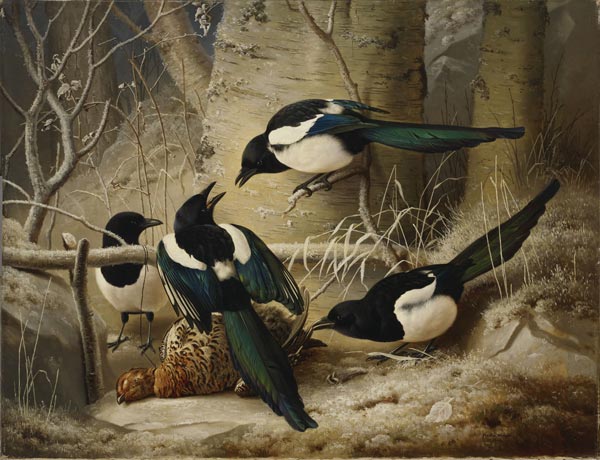
Many blackbirds live in our garden and I have also painted them in 2021.

I find it fun to adjust abstract shapes so that they express the essence of the bird. Here’s the Kingfishers painting again, photographed by my husband in the front garden.
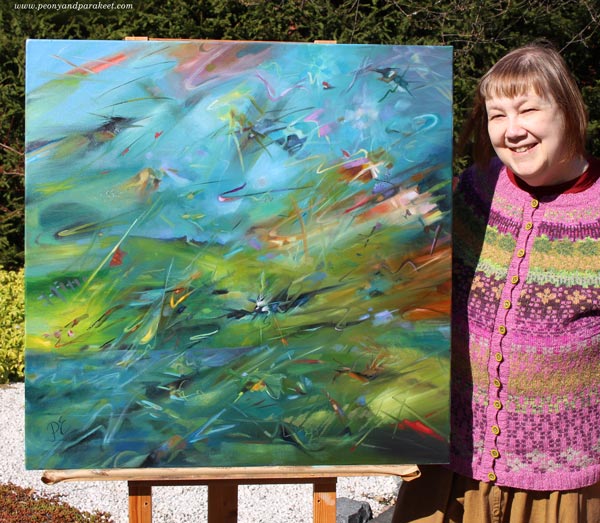
And here are some pictures of details so that you can examine brush strokes and abstract birds more closely.
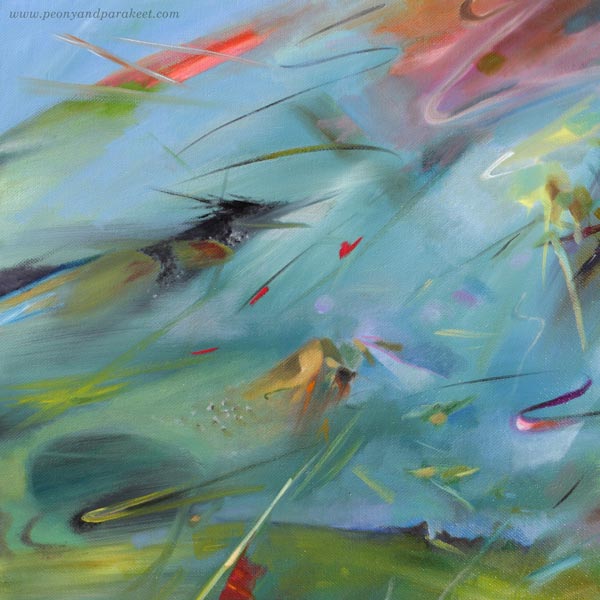
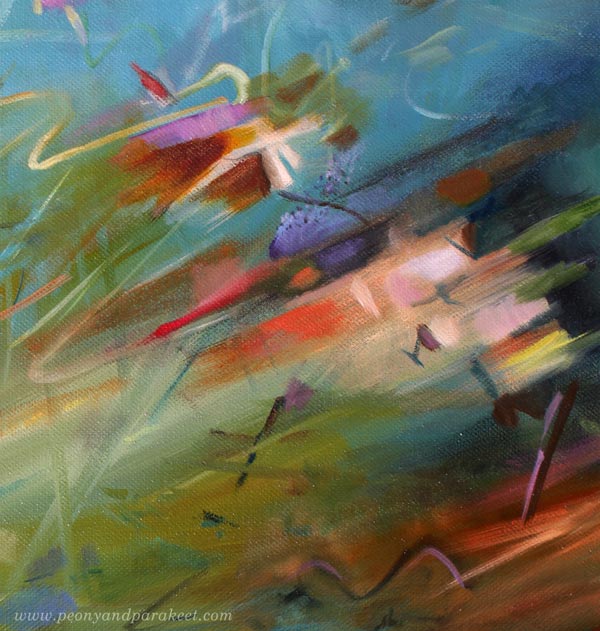
If you think about kingfishers, painting them can’t be just about flying near a stream, it has to be about catching fish too. To bring that up, the bird on the left below looks a bit like a fish.
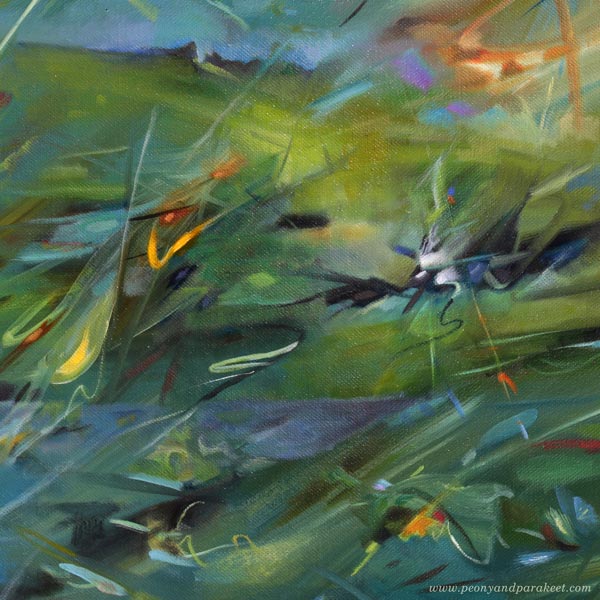
Not So Abstract Birds to Get to Know Them
Of course, a flying bird can also be created so that it’s not abstract but has many decorative details. This project is from the course Animal Inkdom and is drawn in several sessions piece by piece so that it’s more manageable and fun.
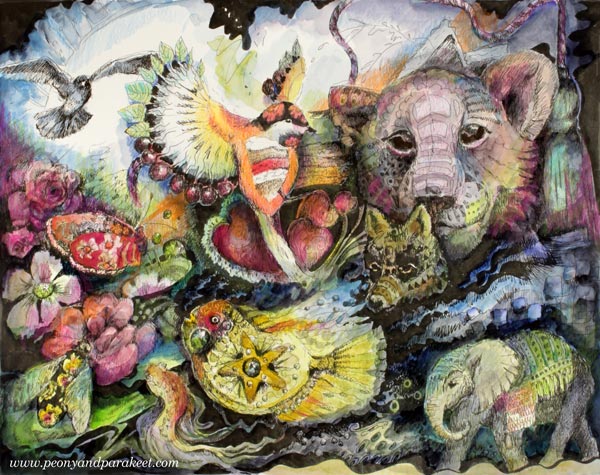
In the center is a bird that flies into the animal world. When re-examining this, I hope that over time I would paint all kinds of animals in my abstract style. It is often necessary to study the animal for a long time before an abstract can be derived from it.
The Connection Between Letting Go and Not Letting Go

So if you wish that your expression would be freer, one way is to go deep into the subject. Not just to look at what a kingfisher looks like, for example, but to live its life, experience a deep identification with it and look for forms that express that emotional connection.
Often both the forms and the connection are first found through creating art that is less abstract and more accurate. I think that it would have been quite easy for the Von Wright brothers to become abstract bird artists, but the time wasn’t right for them. They left a legacy though, and I am one of their followers.
Get Creative in Drawing Ornaments!
This month, the focus is on art history. Art history is often talked about in a very serious tone, but let’s examine it through imagination and start by drawing ornaments!
Ornament Tells a Story from Childhood
It’s fascinating that even if the ornaments are stiff and organized compositions, one can express a whole story.
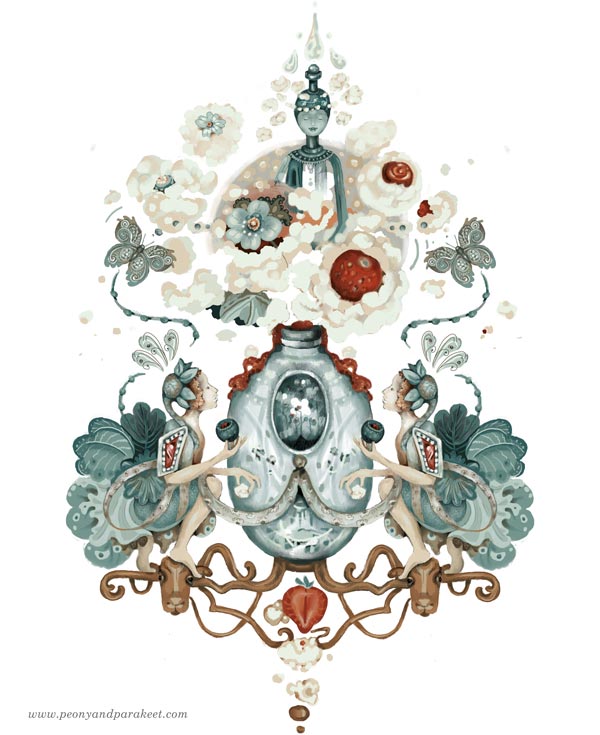
The background of this drawing is a funny story from my childhood. When the school asked each student’s favorite food, I answered “Mansikoita ja kermavaahtoa!” – Strawberries and whipped cream” while the others listed macaroni dishes or meatballs. Both the teacher and the students were quite shocked by the answer, but I wondered how anyone would prefer to eat something so modest and usual.
This story tells a lot about how I’ve always wanted to get away from the mundane. I still want to draw things so that they look like a luxurious celebration rather than a gray everyday life. I like drawing jewels, lace, floral motifs, and swirls, and you can have a lot of those on the ornaments.
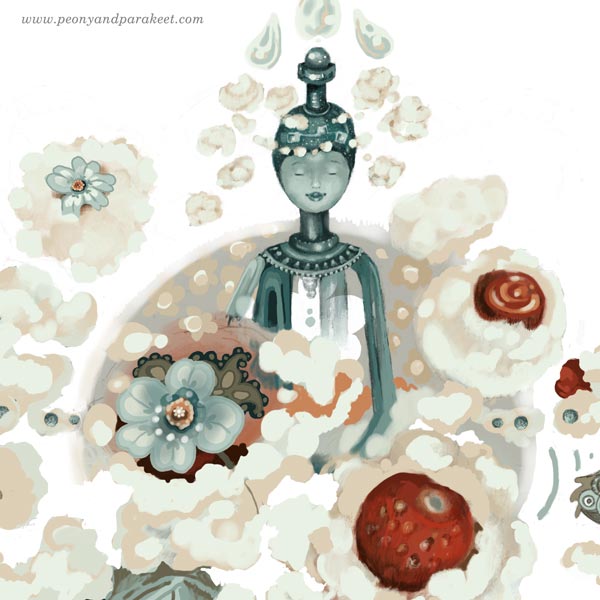
I often want to include people or animals too. For example here, I wanted to make the whisk half-human, and draw two fairies that enjoy the dessert.
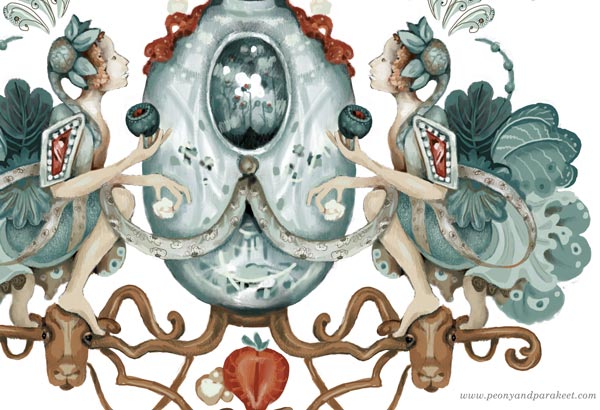
The method that I teach for human poses in the course Doll World was very helpful here.
Inspiration from Antiques, Old Buildings, and Paintings
There are plenty of ornaments in my photo archive. When I visit old buildings, I go through doors, ceilings, wall panels, and floors, looking for nice ornaments.
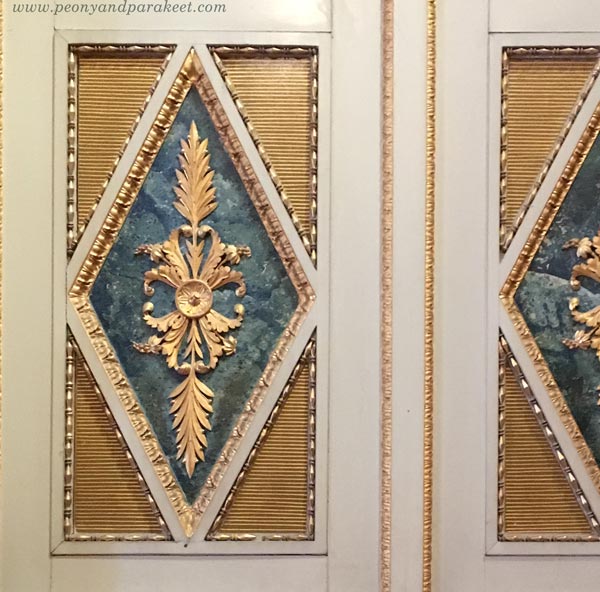
I also love to examine antiques closely.
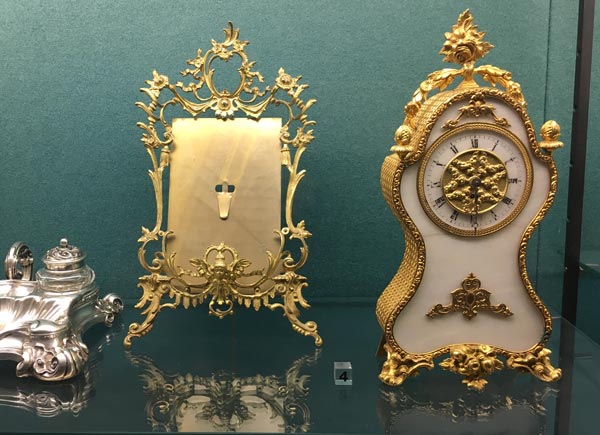
Old paintings often have lovely frames. Whenever I photograph one, I always try to include the frame in the picture.
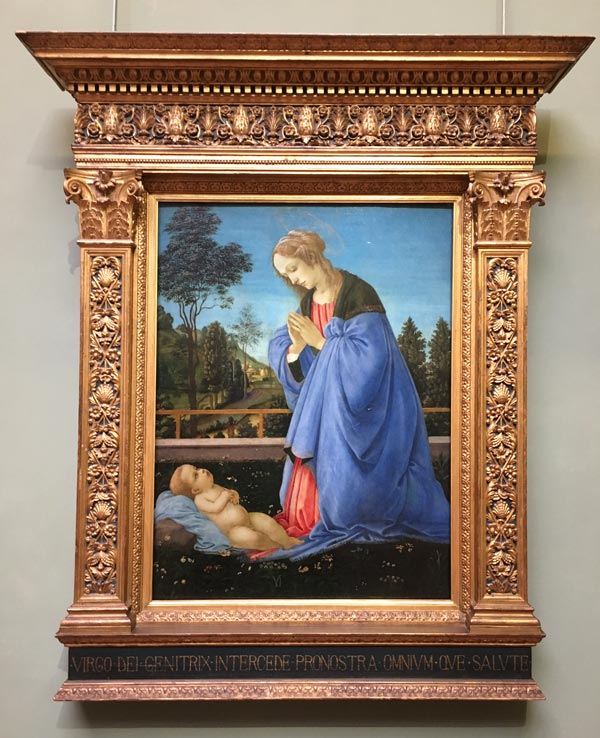
This frame is like an ornament representing a palace!
Lots of Simple Shapes
The decorative appearance of the ornaments can mislead you into overestimating their complexity. When an ornament is taken apart, the shapes can be quite simple.
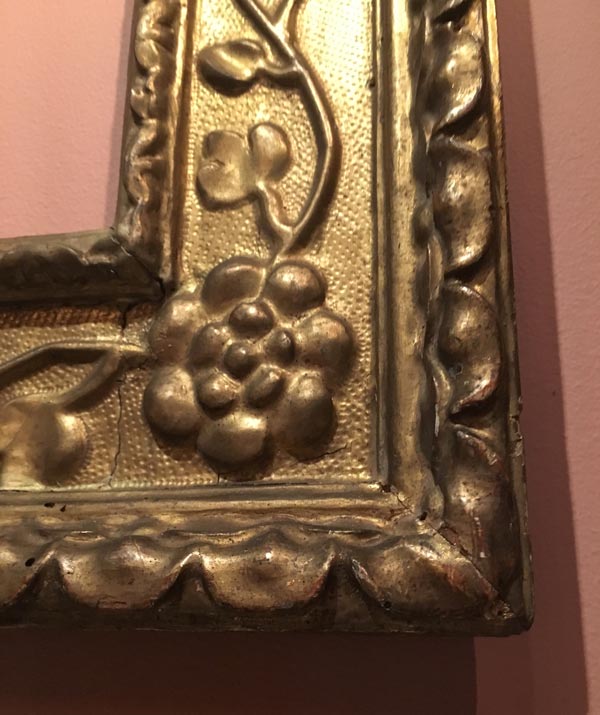
I love this kind of sophistication based on quantity and repetition, with which you can express anything – humorous subjects …
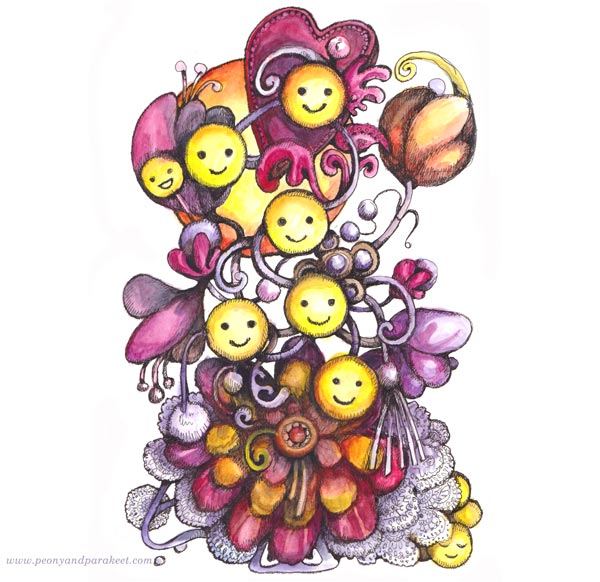
… or more serious.
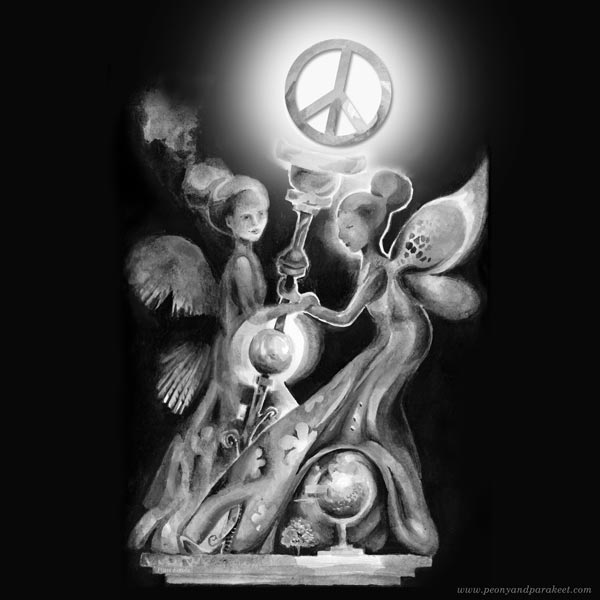
This example shows well that you can also express light when drawing ornaments.
Ornaments Can Both Hide and Reveal
I am fascinated by the fact that although the subject can be drowned in decorative forms, it can also be brought out more directly and more concisely than in a regular drawing. Time travel to the past can become surreal when the horizon disappears and the items are arranged as part of a floating structure.
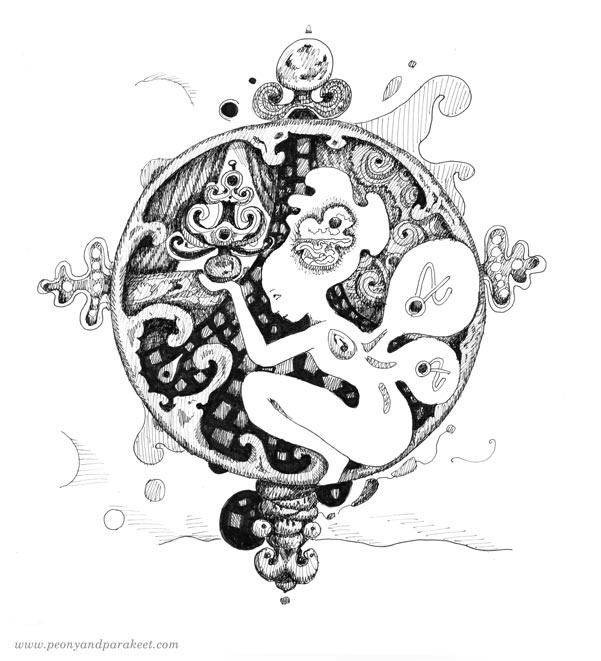
Ornaments as Collage Art
If drawing the whole ornament in one go feels too demanding, remember that the ornaments can also be collage art. You can glue individual elements so that they form a decorative tree or medallion. I have put together many kinds of ornaments from hand-drawn animals and hand-decorated papers.
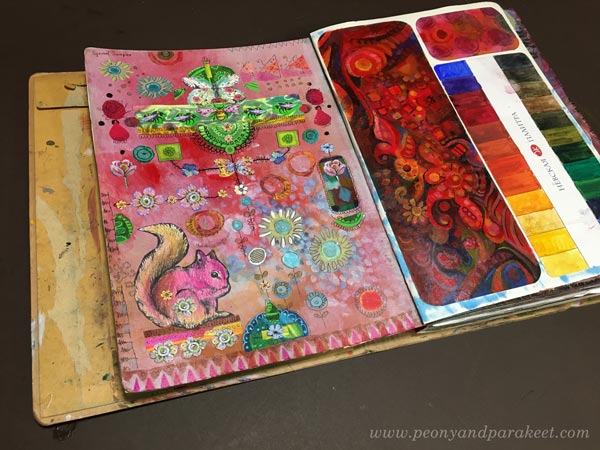
You can also scan or photograph the drawings and assemble the ornament digitally with an image processing program. Here are animal figures and flowers from the course Animal Inkdom and a teacup from the course Magical Inkdom.
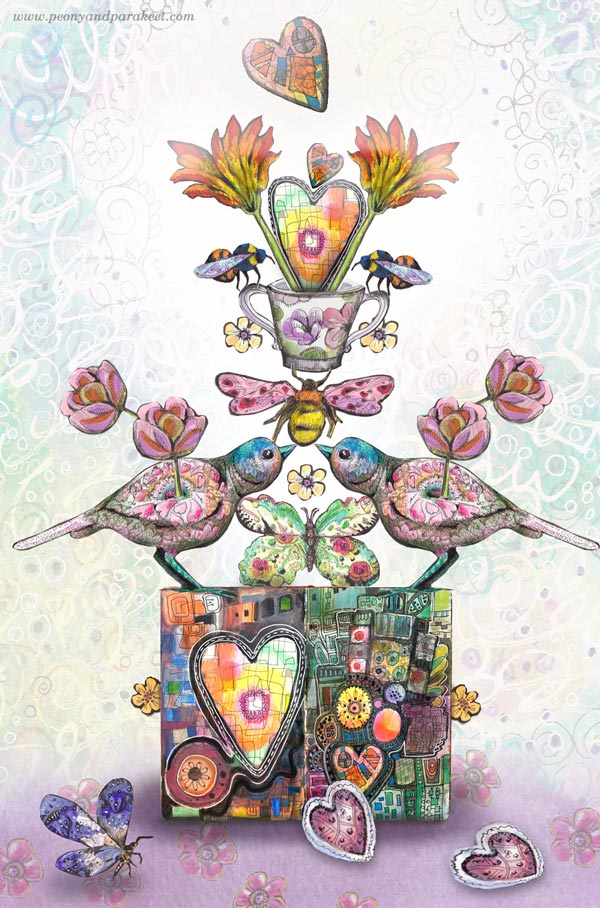
Drawing Ornaments is Expressing the World
After working with ornaments for a while, you begin to realize that the world is largely based on them. Surface patterns are everywhere. The beauty of organic forms can be found in all living things.
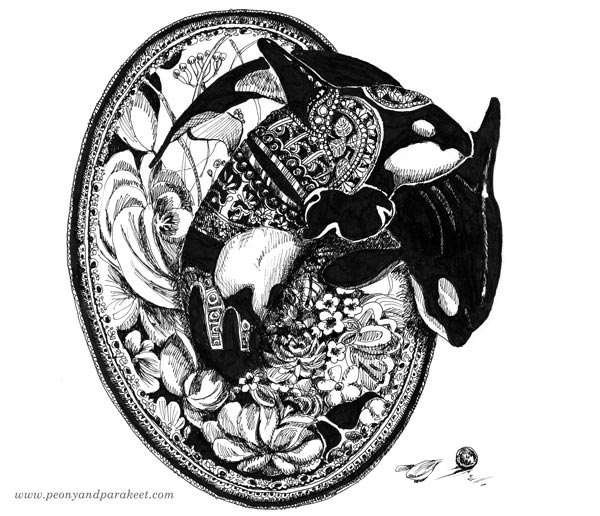
Ornaments build a bridge between the living and the non-living. They make the living an object and the object alive.
Hidden Love for Ornaments and How it Shows
I think that many of us have an innate need to design ornaments. Maybe you dream about designing fabrics or have a huge stash of them. Maybe you collect jewelry or save photos of them. Maybe you feel that something is lacking if you only draw or paint complete images and are not able to rearrange the composition so that it’s something more stylish and less representational.
I only realized this tendency of mine when I made ornaments as part of the illustration for a children’s book. Back then, I used transparent marker paper to design the symmetry, and my desk was full of different versions.
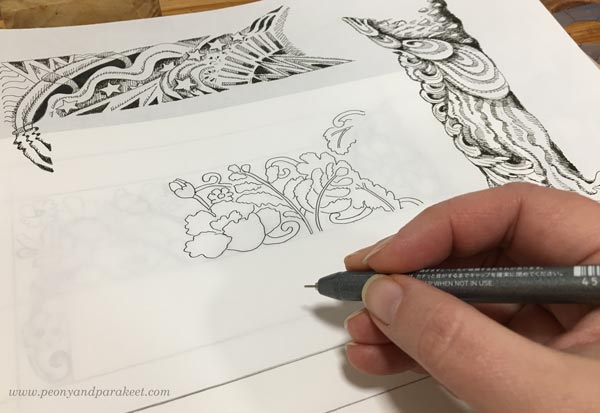
One day when picking the pen, I suddenly felt happy and meaningful: “I should do this more!” Since then, I have not underestimated even the smallest encounters with ornaments.
Drawing Ornaments Inspired by Embroidery
I relax from my work as an artist by doing cross-stitch and those projects also inspired me to draw ornaments.
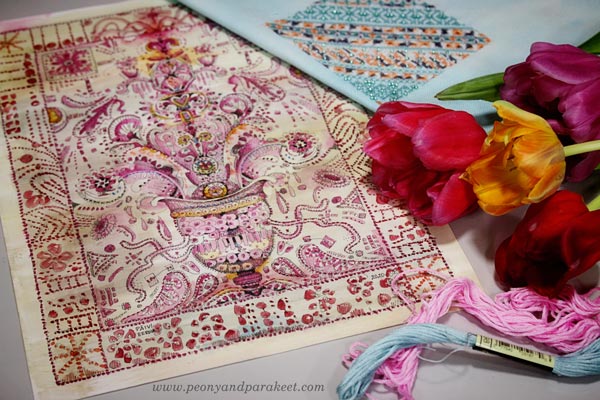
See here how to draw and color an embroidery-inspired ornament – Doodler’s Sampler Step by Step!
Drawing Ornaments without Perfect Symmetry
I drew the last ornament with the ProCreate app. The good things about it are that the background can be kept separate so that the background colors can be varied and it is easy to create symmetry. However, I think completely symmetrical ornaments are a bit too stiff and boring, so I also made quite a lot of asymmetry for this ornament.
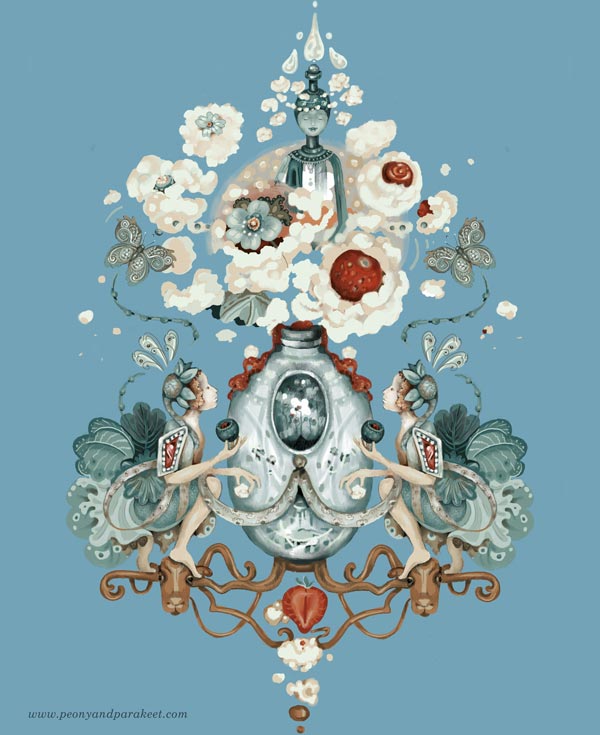
I hope you will start drawing ornaments right away whatever technique you choose!
Related Courses
- Doll World – drawing human poses – Buy here!
- Animal Inkdom – drawing animals – Buy here!
- Magical Inkdom – drawing fantasy – Buy here!
- Collageland – inspired by embroidery – Buy here!